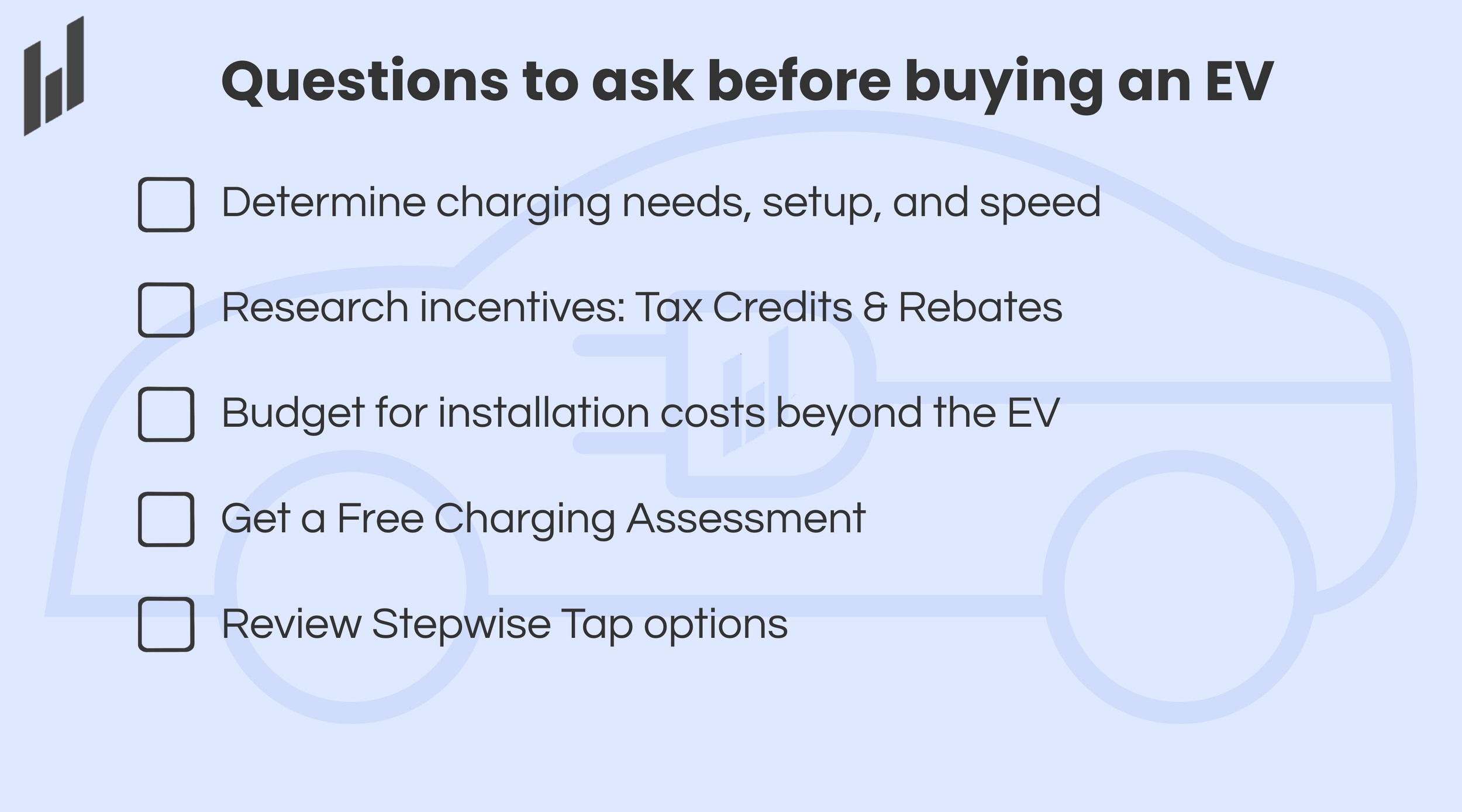EV Checklist: What to Know Before Buying an EV
Buying an electric vehicle (EV) is an exciting step toward an excellent driving experience and a more efficient future. But before you take the leap, there are a few key considerations to ensure your EV ownership experience is smooth and cost-effective. Use this checklist to get prepared:
1. Assess Your Driving Needs
Daily Commute & Range: Estimate your average daily mileage and consider your driving habits. If your daily range is modest (under 50 miles), most EV’s can meet your needs. For longer commutes, look for models with ranges above 200 miles.
Charging Access: Consider whether you'll primarily charge at home, at work, or on the road. Home charging is convenient and cost-effective, and Stepwise Tap™ ensures your home setup is affordable and ready.
2. Explore New vs. Used Options
Budget Considerations: New EVs may qualify for federal and state tax credits or rebates, which can significantly lower upfront costs. However, used EVs are often more affordable upfront and can still deliver excellent performance.
Battery Health: When buying used, request a battery health report to ensure you're getting good value. Battery degradation is minimal in many models but worth checking.
3. Understand Incentives and Rebates
Local & Federal Incentives: Check for federal tax credits (up to $7,500 for new and $4,000 for eligible used EVs) and local rebates in your area. In Massachusetts, for example, your area offers additional rebates for EV charger installation with Stepwise Tap.
Total Cost of Ownership: EVs often have lower maintenance costs and can save you money on fuel over time. Combine this with the Stepwise affordable smart energy management device to maximize savings.
4. Research Vehicle Features
Battery Size and Range: Choose a vehicle with a range that suits your lifestyle. Most newer EVs now offer ranges exceeding 250 miles, but older or smaller models may offer ranges of 100-150 miles.
Technology & Comfort: Look for features like regenerative braking, advanced driver-assistance systems, and infotainment options that enhance your driving experience.
6. Assess Your Charging Needs
Home Charging Setup: Do you have the infrastructure for EV charging at home? Check if your home’s electrical panel has the capacity or if you might benefit from a solution like Stepwise Tap.
Charging Speed: Consider whether you need a standard Level 1 charger or a faster Level 2 solution.
Pro Tip: Many homeowners are qualifying for tax incentives and rebates in some cases, covering up to 100% of installation costs, including the Stepwise Tap device.
7. Take Advantage of Stepwise’s Free Assessment
Not sure if your home is ready for EV charging? Stepwise offers a free assessment to help you determine your needs, maximize savings, and enjoy a hassle-free installation experience.
Start Your Free Home Assessment Now Or Get in Touch
Electric vehicle charging (new or existing charger)
Accommodate 2 EV chargers or make room for a heat pump
Hot tubs
Electric HVAC - resistive heating elements, including space heaters
Water heaters
Pool Pumps
8. Common Pitfalls to Avoid
Overlooking Charging Needs: Many EV buyers focus on the car but neglect home charging setup. Stepwise eliminates this worry with affordable, fast solutions.
Ignoring Rebates: Don’t leave money on the table. Check all local, state, and federal rebates for maximum savings.
Buying More Than You Need: Consider your real driving and charging needs to avoid overspending on features or unnecessary upgrades.
Preparing for EV ownership doesn’t have to be overwhelming. With the right planning and resources—including Stepwise’s innovative Stepwise Tap, incentives, and rebates—you can enjoy the convenience and cost savings of driving electric. Start your journey today by following this checklist and exploring how Stepwise can help make your EV transition seamless.


